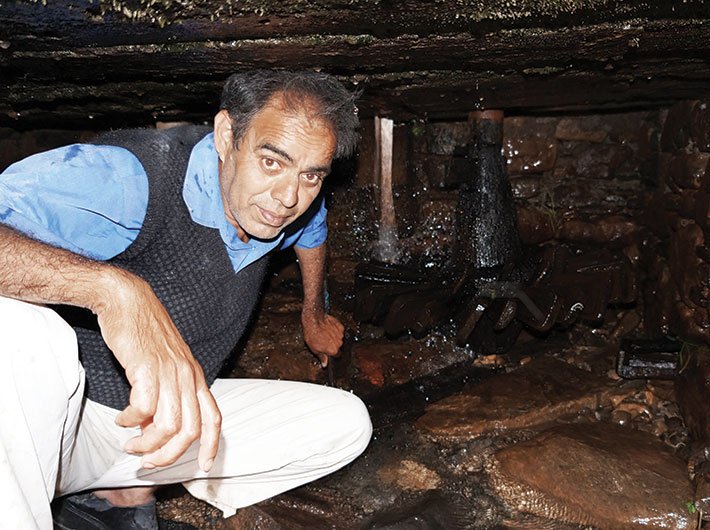His lack of education did not matter when it came to setting up the eco-friendly, hydro-powered flour mill in a Tehri village
He is a man of few words, but 51-year-old Gyandev Tiwari has an interesting story to tell. Nearly 30 years ago, he decided to realise his childhood dream of turning the brutal force of the Satyon river’s water into a power horse that can help turn the wheels of his flour mill. Today, he is living the dream that serves eight nearby villages in Jaunpur block, besides the 25 families of Manj Gaon village in Tehri Garhwal district of Uttarakhand.
As the youngest child of the family, after four sisters, Gyandev got the opportunity to study till class eighth from the inter college in Pujar Gaon; he decided to quit studies due to poverty and joined his father to support family agriculture. However, the eight years were sufficient to ignite the tender mind towards the tremendous potential of hydro-power, and justify his name which literally means the ‘god of knowledge’.
“During one of my school projects I was working with a hollow wood. When water from a pipe attached overhead passed through it at high speed, it moved the small pebble below. That set me thinking and I started experimenting further,” says the father of three – two daughters and a son.

Soon he was able to create a working model of a water-wheel that had blades that would rotate with the force of water. Initially, Gyandev would increase the height of the source of the water to increase the pressure. However, later he started to manage the flow by adjusting the inlet size. The next task at hand was to use the water-wheel to turn a gear that could in turn help rotate the stones that are used to grind grains.
 “I do not remember why I thought about setting up a flour mill, but I do remember trying it out with two small round stones,” he said adding that, “perhaps I saw a gharat (traditional watermill in the Himalayan region) in some village and realised that I can also make one.” With nobody to guide him, except a few books that he had borrowed from friends, it took him more than two years to get the first model running.
“I do not remember why I thought about setting up a flour mill, but I do remember trying it out with two small round stones,” he said adding that, “perhaps I saw a gharat (traditional watermill in the Himalayan region) in some village and realised that I can also make one.” With nobody to guide him, except a few books that he had borrowed from friends, it took him more than two years to get the first model running.
The next big job was to set up the real mill. He replicated the model near his field that luckily was adjacent to the mountain river Satyon (the villagers believe it flows from the Surkanda Devi temple). Initially he got a guy to chisel two grounding wheels using the local mountain stone. He dug a channel along the river to divert water up to his mill-house. While the grinding stone was set up at the upper level of the mill, the water from the channel was diverted through a hollow wooden chute to the flat wooden blades around 15 feet below. The chute had a narrow opening to increase the force of the falling water that rotated the wheel, which in turn, rotated the metal shaft attached to the grinding stone above.

However, he soon realised that the local stone was no good as it broke very soon. The news of his experiment had spread and a mill owner from another village gave him the contact of the milling stone supplier in Agra. It took him another six months to raise funds for the milling stone, but the guy who came to set it proved to be his best man.
From lab to work
While the gharats have been used traditionally in the Himalayan region, including the northeastern region, they have been replaced by modern electricity-powered mills that are believed to be more commercially viable. Hence, it took his supplier from Agra a while to understand how to get Gyandev’s gharat running. He advised Gyandev to use better quality wood blades and taper the thick wooden shaft from both ends. This helped him properly fit the millstones at the top of the shaft to act as the grinding mill. And as he realises now, it also helped him reduce the wear and tear, despite the fact that the blades have to be tightened and fixed every two years and replaced in four-five years.

The wooden shaft of the turbine was supported on a stone pivot through a steel pin that was held in the sliding bearing – a wooden bush fixed in the lower stationary grinding stone – at the top in a way that the top-grinding wheel can rest on the lower stone. This ensured that the top-grinding wheel would rotate with the turbine shaft through a straight slot coupling. The man also helped Gyandev set up a mechanical lever that moves up and down to increase and decrease the gap between the stationary and the moving millstones.
“By tightening the lever wheel I can decrease the distance between the two stones for fine grinding. The process can be reversed to increase the distance between the grinding stones for coarse grinding,” he said. He further explained that the blades of the water wheel are fixed lengthwise at the axis to transmit the entire load to an iron base, which is connected to the upper part of the grinder stone using the shaft. Gyandev also informed that he has created two sluice gates to manage water better, which also comes handy in stopping the mill.
Over the years, he has set up a permanent structure to house the mill which once got washed away in the flash flood. He has also added a second unit and the sluice gate helps him divert water to either or both of them. And while he only gets paid in kind – the miller’s toll or a percentage of flour that he grinds – Gyandev is satisfied with the respect that he has got. He is also happy that unlike many others who set up similar water mills, he has been able to stay up and running for over two decades now.
 “While we use the flour that I get as a fee, I get enough business to be able to sell flour to those who do not have their own fields. Wheat flour sells at '18 per kg,” he said. Off late, his water-mill has also become a favourite spot for tourists, particularly with a local resort in Kanatal deciding to showcase the hydro project as part of the village tourism agenda. “This gives me some additional income, but it also gives me a sense of pride that my eco-friendly effort has bought the village on the tourism map,” he said with a glint in his eyes.
“While we use the flour that I get as a fee, I get enough business to be able to sell flour to those who do not have their own fields. Wheat flour sells at '18 per kg,” he said. Off late, his water-mill has also become a favourite spot for tourists, particularly with a local resort in Kanatal deciding to showcase the hydro project as part of the village tourism agenda. “This gives me some additional income, but it also gives me a sense of pride that my eco-friendly effort has bought the village on the tourism map,” he said with a glint in his eyes.
The author visited the village and the hydro flour mill as part of the bloggers’ meet organised by The Terraces, a boutique spa resort in Kanatal.
[email protected]
(The article appears in the February 16-29, 2016 issue)



